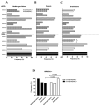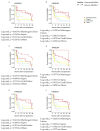Presence of KIR2DL2/S2, KIR2DL5, and KIR3DL1 Molecules in Liver Transplant Recipients with Alcoholic Cirrhosis Could Be Implicated in Death by Graft Failure
- PMID: 37046435
- PMCID: PMC10093628
- DOI: 10.3390/diagnostics13071217
Presence of KIR2DL2/S2, KIR2DL5, and KIR3DL1 Molecules in Liver Transplant Recipients with Alcoholic Cirrhosis Could Be Implicated in Death by Graft Failure
Abstract
Background: The second-most frequent diagnosis among patients receiving liver transplants (LTs) is alcoholic liver disease. The multifactorial pathophysiology of alcoholic liver disease depends on the innate immune system and the inflammatory cascade. According to recent studies on these receptors, killer-cell immunoglobulin-like receptors (KIRs) may be involved in sepsis, liver rejection, and virus relapse. We aimed to investigate the impact of preclinical issues like ascites and encephalopathy and KIR genetic traits on death from sepsis, multiorgan failure (MF), and graft failure (GF) in AC patients undergoing LTs. Methods: We retrospectively reviewed 164 consecutive and deceased Caucasian AC patients who underwent LTs. Pre-transplant complications, cause of death, and patient survival were analyzed. Genomic DNA was taken from peripheral blood, and PCR-SSO was used for genotyping KIR. Results: Compared to GF patients, there was a statistically significant increase in the frequency of KIR2DL2+ (75.8% vs. 51.2%; p = 0.047). Another increase in frequency was also observed in KIR2DS2+ in sepsis compared to the GF group (51.2% vs. 43.7%; p = 0.018). In patients who passed away from MF, a decrease in KIR2DL5+ was observed in AC patients with and without encephalopathy (p = 0.018). The frequency of KIR3DL1+ in the AC patients significantly increased the mortality from sepsis (p = 0.045), which was confirmed by multivariate logistic regression. The frequency of KIR3DL1+ in the AC patients significantly increased the mortality from sepsis (p = 0.012) and was confirmed by multivariate logistic regression. KIR2DS1+ and KIR2DS4+ showed increased mortality due to GF compared to patients without these genes (p = 0.011 and 0.012, respectively). However, this fact was confirmed only for KIR2DS1+ by multivariate logistic Cox regression. Conclusions: The presence of the KIR2DL2/S2+, KIR2DL5+, and KIR3DL1+ genes increases the frequency of death from multiple organ failure or graft failure. Our findings highlight the AC patient's vulnerability to a LT during hospitalization. Following the transplant and outside of it, we adopt essential preventive measures to create a routine healthcare screening to enhance and modify treatments to increase survival.
Keywords: KIR genes; alcoholic cirrhosis; causes of death; liver transplant; sepsis.
Conflict of interest statement
The authors declare no conflict of interest.
Figures




Similar articles
-
Causes of Death and Survival in Alcoholic Cirrhosis Patients Undergoing Liver Transplantation: Influence of the Patient's Clinical Variables and Transplant Outcome Complications.Diagnostics (Basel). 2021 May 27;11(6):968. doi: 10.3390/diagnostics11060968. Diagnostics (Basel). 2021. PMID: 34072173 Free PMC article.
-
Is the Development of Ascites in Alcoholic Liver Patients Influenced by Specific KIR/HLA Gene Profiles?Biomedicines. 2023 Aug 28;11(9):2405. doi: 10.3390/biomedicines11092405. Biomedicines. 2023. PMID: 37760846 Free PMC article.
-
Killer Cell Immunoglobulin-like Receptors (KIR) and Human Leucocyte Antigen C (HLA-C) Increase the Risk of Long-Term Chronic Liver Graft Rejection.Int J Mol Sci. 2022 Oct 12;23(20):12155. doi: 10.3390/ijms232012155. Int J Mol Sci. 2022. PMID: 36293011 Free PMC article.
-
Distribution of the killer cell immunoglobulin-like receptors in Mexican Mestizos.Tissue Antigens. 2007 Apr;69 Suppl 1:125-9. doi: 10.1111/j.1399-0039.2006.76212.x. Tissue Antigens. 2007. PMID: 17445185
-
Are killer cell immunoglobulin-like receptor genes important for the prediction of kidney graft rejection?Arch Immunol Ther Exp (Warsz). 2013 Aug;61(4):321-5. doi: 10.1007/s00005-013-0225-2. Epub 2013 Apr 4. Arch Immunol Ther Exp (Warsz). 2013. PMID: 23552952 Review.
References
-
- Legaz I., Navarro-Noguera E., Bolarín J.M., García-Alonso A.M., Luna Maldonado A., Mrowiec A., Campillo J.A., Gimeno L., Moya-Quiles R., Álvarez-López M.D.R., et al. Epidemiology, Evolution, and Long-Term Survival of Alcoholic Cirrhosis Patients Submitted to Liver Transplantation in Southeastern Spain. Alcohol. Clin. Exp. Res. 2016;40:794–805. doi: 10.1111/acer.13013. - DOI - PubMed
Grants and funding
LinkOut - more resources
Full Text Sources

